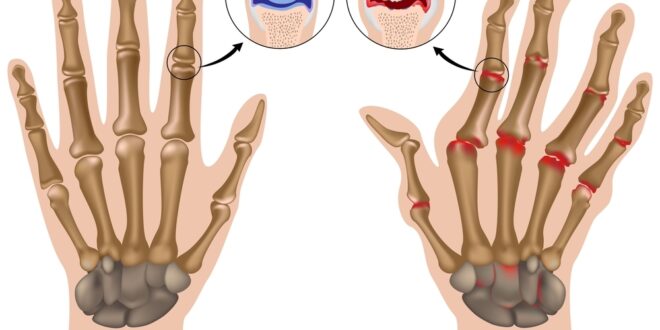Therapy for Rheumatoid Arthritis in the Hand
Several types of therapies can be used to manage the symptoms of rheumatoid arthritis (RA) in the hand. Here are some examples:
- Medications: Nonsteroidal anti-inflammatory drugs (NSAIDs) can be used to reduce pain and inflammation in the hand joints. Disease-modifying antirheumatic drugs (DMARDs) and biological agents can help to slow the progression of RA and prevent joint damage.
- Physical therapy: A physical therapist can work with a person with RA in the hand to improve hand strength and range of motion. They may use exercises, splints, or assistive devices to help manage symptoms.
- Occupational therapy: An occupational therapist can help a person with RA in the hand to perform daily activities more easily by modifying the environment, providing adaptive equipment, and teaching techniques to conserve energy and reduce joint stress.
- Heat and cold therapy: Applying heat or cold to the affected hand joints can help to reduce pain and inflammation. A person can use a heating pad, warm towel, or ice pack for this purpose.
- Acupuncture: Some people find relief from RA symptoms in the hand with acupuncture. This involves the insertion of thin needles into specific points on the body to help alleviate pain and inflammation.
- Surgery: In severe cases of RA in the hand, surgery may be necessary to correct a joint deformity or replace damaged joints. This is typically reserved for cases where other treatments have not been effective.
It is important to work with a healthcare provider to develop an individualized treatment plan for RA in the hand. Early diagnosis and treatment can help to slow the progression of the disease and improve quality of life.
What Occupational Therapists Do
Occupational therapists (OTs) are healthcare professionals who help people of all ages to improve their ability to perform everyday activities, also known as “occupations.” The goal of occupational therapy is to help individuals achieve independence and improve their quality of life. Here are some of the things that occupational therapists do:
- Evaluate clients: Occupational therapists evaluate a client’s physical, cognitive, and emotional abilities to determine their strengths and limitations. They also assess the client’s environment, including their home and workplace, to identify barriers to performing daily activities.
- Develop treatment plans: Based on the evaluation, occupational therapists develop a personalized treatment plan for each client. This may include exercises, adaptive equipment, modifications to the environment, and education on how to conserve energy and prevent injury.
- Provide therapy: Occupational therapists work with clients one-on-one to help them develop the skills and strategies they need to perform daily activities. This may involve teaching them how to use adaptive equipment, practicing specific exercises to improve hand strength or dexterity, or developing strategies to manage pain or fatigue.
- Collaborate with other healthcare professionals: Occupational therapists often work closely with other healthcare professionals, such as physical therapists, speech therapists, and social workers, to provide coordinated care for their clients.
- Educate clients and caregivers: Occupational therapists provide education to clients and their caregivers on how to manage their condition and how to perform daily activities safely and effectively.
- Advocate for clients: Occupational therapists advocate for their client’s needs and work to improve access to services and resources that can help them achieve their goals.
Occupational therapy is a client-centered and holistic approach that can help individuals of all ages and abilities to achieve greater independence and improve their quality of life.
Hand Exercises for Rheumatoid Arthritis
Hand exercises can help improve flexibility, reduce stiffness and pain, and strengthen the muscles in the hands for individuals with rheumatoid arthritis. Here are some hand exercises that can be helpful:
- Finger stretches: Hold your hand out in front of you with your fingers straight. Slowly curl your fingers into a fist, then slowly straighten them out again. Repeat 10 times.
- Thumb stretches: Hold your hand out in front of you with your palm facing up. Touch the tip of your thumb to the tip of your pinky finger, then slowly open your hand and touch your thumb to your ring finger. Continue touching your thumb to each finger in succession, then reverse the order. Repeat 10 times.
- Finger taps: Tap each fingertip to your thumb as quickly as you can, then switch hands and repeat.
- Grip exercises: Squeeze a soft rubber ball or a hand grip strengthener to strengthen the muscles in your hands. Start with a light resistance and gradually increase as you get stronger.
- Wrist curls: Hold a lightweight in your hand, such as a small dumbbell or a water bottle. Sit with your forearm resting on a table or bench with your hand hanging off the edge. Slowly curl your wrist upward, then lower it back down. Repeat 10 times, then switch hands.
Remember to take breaks and rest your hands if you start to feel any pain or discomfort. It’s also important to consult with your healthcare provider or a licensed occupational therapist before starting any exercise program, especially if you have severe rheumatoid arthritis or other medical conditions.
Hand Rheumatoid Arthritis Signs and Symptoms
 Shalkot The Innovators
Shalkot The Innovators




